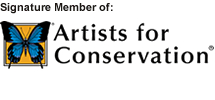 |

          
 
Page Counter: 222362
Members
Login
|
|


| |
Mary Louise HoltNATURE'S PAST,PRESENT AND FUTURE
AN HISTORICAL PERSPECTIVE
I like to bring to life on canvas compelling images from nature's past and present but as I do I'm always mindful of its future.
THE PAST: Today it is hard to imagine that the eastern half of the United States was once a patchwork of massive old growth forests, prairies, canelands, pristine rivers and a rich diversity of flora and fauna. As a child growing up in the Ohio Valley my lively imagination carried me back to that time. The tall buildings of the city were transformed into immense forests that towered over me. I could also see in my mind the elk, mountain lions, buffalo and bear that once roamed free on this great land. As Caleb Atwater wrote in his book, A History of Ohio, " The prairies were intermingled with flowering shrubs, tall grasses and a profusion of wildflowers of every shade and color. All was silent and still except for the bees and singing birds of every variety."
This is what the first European settlers saw as they traveled west through the Appalachian Mountains and beyond. But a little known fact is that this vast wilderness was not a wilderness at all. The Native Americans had been altering their environment since sometime in the first millennium AD. They did this to create more sources of food for themselves. Two examples are the way they planted more fruit and nut-bearing trees. The American Chestnut, for example, was one of their favorites. By the 18th century as many as one out of every four trees between southeastern Canada and Georgia was a Chestnut. This is partly a result, it would seem, from indian burning and planting. They also burned areas of forests to create prairies. This made game easier to hunt and the creatures attracted to these open, sunny areas provided new sources of nutritious food. The Indians believed that the land was a treasure in trust, given to them to use wisely and well so that it could be passed down to future generations.
THE PRESENT: When I create images from the present state of nature I am hopeful. There seems to be a growing awareness that we must now live sustainably with nature. It seems to me that, when it comes to nature, the American Indians were ahead of their time. How different the world would be if we had learned some of their ways.
THE FUTURE: I hope you enjoy my work depicting nature's past and present. I remain hopeful for our future. I also hope you will appreciate, as I do, the great natural treasures that are now in OUR trust.
|
|
|
|
 |
 |
.jpg)

|
 |
Give and Take
Fort Ancient Indian Hunters, Ohio Valley, 17th Century
20 x 16
Oil
Ltd. Edition Available
|
 |
|
|
 |
 |


|
 |
The Persistence of Pileateds
(2014)
Pileated woodpecker and autumn leaves
12 x 9 x 2 (inches)
oil on canvas
Original Available
Ltd. Edition Available
Pledge Amt: 10%
to
|
 |
|
|
|
|
| |
 |
|
|
 |
 |
|

|
|
|
All rights reserved. All images and text © Copyright 2024 Mary Louise Holt - Member of the Artists for Conservation Foundation (Formerly
the Worldwide Nature Artists Group) www.natureartists.com.
This site represents the original artwork (nature art and wildlife art) of nature
artist and wildlife artist of Mary Louise Holt and is protected by international copyright laws. Use
of nature art, wildlife art or any other images or text from this site, requires
permission in writing from Mary Louise Holt ().
This site is part of the Artists for Conservation (AFC) Web site. (Wildlife
Art - Nature Art - Conservation) Artists for Conservation is an international, non-profit organization dedicated to
nature art, wildlife art and conservation. On this site you will find world-class
nature art and wildlife art by today's leading nature artists & wildlife artists.
The AFC site is the Web's premier location for nature art, wildlife
artists
All content appearing in pages featuring Mary Louise Holt is the sole responsibility of Mary Louise Holt. The opinions expressed on these artists' pages are those of Mary Louise Holt and do not necessarily reflect those of the Artists for Conservation
Foundationi (AFC).
|


.jpg)
.jpg)

